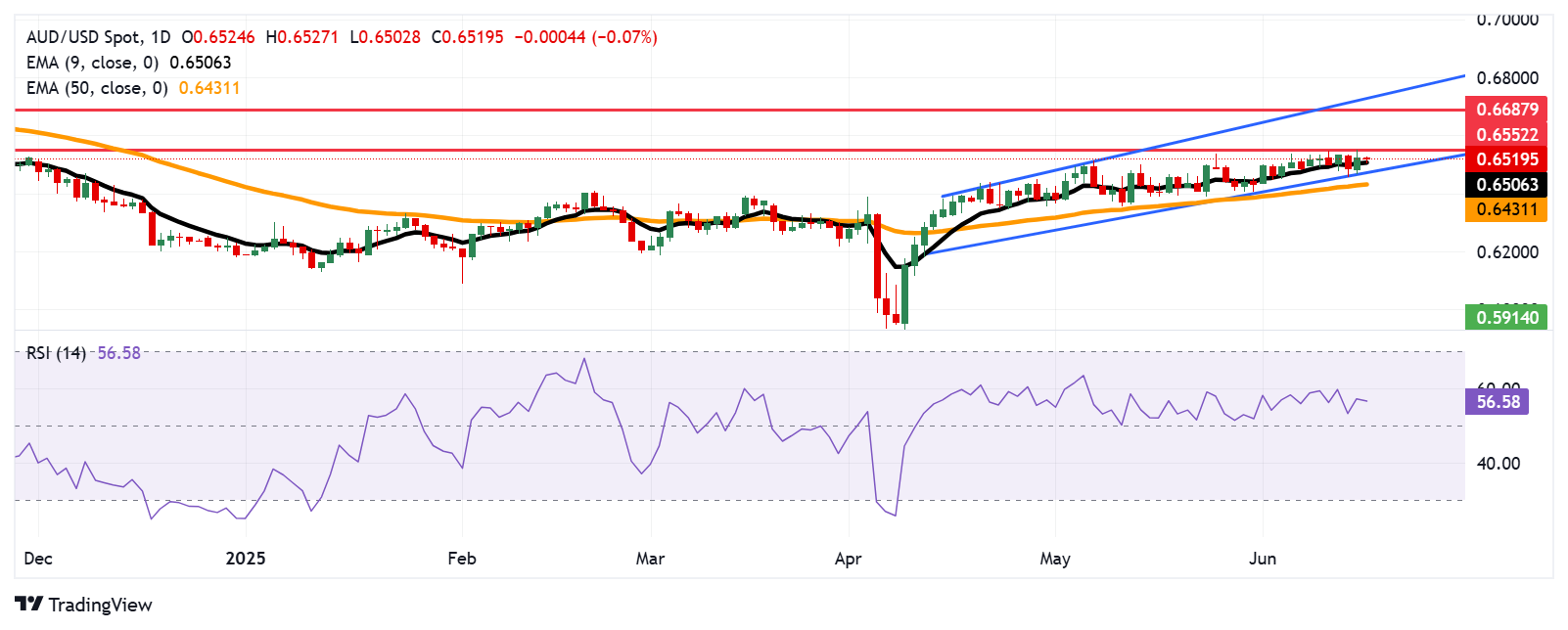
- The Australian Dollar rebounds, trimming daily losses as concerns over Israel-Iran tensions ease.
- Iran asked many countries, including Oman, Qatar, and Saudi Arabia, to urge President Trump to initiate an immediate ceasefire.
- Traders await the US Retail Sales data for May due on Tuesday.
The Australian Dollar (AUD) recovers its daily losses against the US Dollar (USD) on Tuesday. However, the AUD/USD pair faced challenges as traders adopted caution amid ongoing geopolitical tensions.
However, the risk-sensitive AUD/USD pair gained ground due to optimism after Iran reportedly asked many countries, including Oman, Qatar, and Saudi Arabia, to urge US President Donald Trump to use his influence on Israel for an immediate ceasefire, per Reuters. Moreover, risk sentiment improved as the Canadian Prime Minister Mark Carney had agreed with Trump that their two nations should try to wrap up a deal on tariffs within 30 days.
G7 leaders issue a statement, “We have been consistently clear that Iran can never have a nuclear weapon.” They highlighted that resolving the crisis can lead to broader de-escalation of hostilities in the region.
Traders await Australia’s upcoming labor data this week, including Employment Change and Unemployment Rate, which are expected to offer fresh impetus on the strength of the domestic economy and shape expectations for the Reserve Bank of Australia’s (RBA) policy outlook.
Australian Dollar appreciates as US Dollar edges lower due to improved risk sentiment
- The US Dollar Index (DXY), which measures the value of the US Dollar against six major currencies, is trading higher at around 98.20 at the time of writing. The US Retail Sales data for May will be eyed on Tuesday. The focus will shift to the Federal Reserve’s (Fed) interest rate decision, due on Wednesday.
- On Monday, President Trump called for the evacuation of Iran’s capital, Tehran, hours after urging the country’s leaders to accept a deal to limit its nuclear program, as Israel hinted that attacks would continue, per Bloomberg.
- Trump posted in a social media post, “What a shame, and a waste of human life. Simply stated, IRAN CAN NOT HAVE A NUCLEAR WEAPON. I said it over and over again! Everyone should immediately evacuate Tehran. Iran should have signed the ‘deal’ I told them to sign.”
- The University of Michigan (UoM) reported on Friday that the Consumer Sentiment Index climbed to 60.5 in June from 52.2 prior. This reading came in above the market consensus of 53.5.
- The US Producer Price Index (PPI) climbed 0.1% month-over-month in May, compared to a decline of 0.2% (revised from -0.5%). This reading came in softer than the expected 0.2% rise. Meanwhile, the core PPI, excluding food and energy, increased 0.1% MoM in May versus -0.2% prior (revised from -0.4%), below the consensus of 0.3%.
- The US Federal Reserve (Fed) is expected to keep its policy rate unchanged within the 4.25%–4.50% range in its upcoming decision on Wednesday. Traders now expect a 25 basis point rate cut by September.
- Reuters reported Thursday that President Trump expanded steel tariffs starting June 23 on imported “steel derivative products,” including household appliances, such as dishwashers, washing machines, refrigerators, etc. The tariffs were initially imposed at 25% in March and later doubled to 50% for most countries. This is the second time the scope of affected products has been expanded.
- China Retail Sales rose 6.4% year-over-year in May, surpassing the 5.0% expected and April’s 5.1% increase. Meanwhile, Industrial Production increased 5.8% YoY, but came in below the 5.9% forecast and 6.1% prior.
- Moreover, the National Bureau of Statistics (NBS) in China noted that the domestic economy is expected to have remained generally stable for the first half (H1) of 2025. However, economic growth in China may struggle since the second quarter due to uncertain trade policies.
Australian Dollar falls to near nine-day EMA, tests 0.6500
AUD/USD is trading around 0.6510 on Tuesday. The bullish bias prevails, as the daily chart’s technical analysis indicates that the pair remains within the ascending channel. Moreover, the 14-day Relative Strength Index (RSI) remains above the 50 mark, suggesting a prevailing bullish outlook. Additionally, the pair is positioned above the nine-day Exponential Moving Average (EMA), indicating that short-term price momentum is stronger.
The pair may target the fresh seven-month high of 0.6552, which was reached on June 16. A break above this level could support the pair to target the eight-month high at 0.6687, followed by the upper boundary of the ascending channel around 0.6730.
On the downside, the AUD/USD pair may test the nine-day EMA at 0.6506, followed by the ascending channel’s lower boundary around 0.6470. A break below the channel would indicate the weakening of the bullish bias and put downward pressure on the pair to test the 50-day EMA at 0.6431.
AUD/USD: Daily Chart

Australian Dollar PRICE Today
The table below shows the percentage change of Australian Dollar (AUD) against listed major currencies today. Australian Dollar was the strongest against the Canadian Dollar.
| USD | EUR | GBP | JPY | CAD | AUD | NZD | CHF | |
|---|---|---|---|---|---|---|---|---|
| USD | -0.04% | 0.02% | -0.06% | 0.05% | -0.21% | -0.20% | -0.09% | |
| EUR | 0.04% | 0.03% | 0.02% | 0.07% | -0.14% | -0.08% | -0.07% | |
| GBP | -0.02% | -0.03% | -0.10% | 0.04% | -0.17% | -0.15% | -0.10% | |
| JPY | 0.06% | -0.02% | 0.10% | 0.08% | -0.17% | -0.15% | -0.07% | |
| CAD | -0.05% | -0.07% | -0.04% | -0.08% | -0.32% | -0.17% | -0.14% | |
| AUD | 0.21% | 0.14% | 0.17% | 0.17% | 0.32% | 0.05% | 0.08% | |
| NZD | 0.20% | 0.08% | 0.15% | 0.15% | 0.17% | -0.05% | 0.02% | |
| CHF | 0.09% | 0.07% | 0.10% | 0.07% | 0.14% | -0.08% | -0.02% |
The heat map shows percentage changes of major currencies against each other. The base currency is picked from the left column, while the quote currency is picked from the top row. For example, if you pick the Australian Dollar from the left column and move along the horizontal line to the US Dollar, the percentage change displayed in the box will represent AUD (base)/USD (quote).
Australian Dollar FAQs
One of the most significant factors for the Australian Dollar (AUD) is the level of interest rates set by the Reserve Bank of Australia (RBA). Because Australia is a resource-rich country another key driver is the price of its biggest export, Iron Ore. The health of the Chinese economy, its largest trading partner, is a factor, as well as inflation in Australia, its growth rate and Trade Balance. Market sentiment – whether investors are taking on more risky assets (risk-on) or seeking safe-havens (risk-off) – is also a factor, with risk-on positive for AUD.
The Reserve Bank of Australia (RBA) influences the Australian Dollar (AUD) by setting the level of interest rates that Australian banks can lend to each other. This influences the level of interest rates in the economy as a whole. The main goal of the RBA is to maintain a stable inflation rate of 2-3% by adjusting interest rates up or down. Relatively high interest rates compared to other major central banks support the AUD, and the opposite for relatively low. The RBA can also use quantitative easing and tightening to influence credit conditions, with the former AUD-negative and the latter AUD-positive.
China is Australia’s largest trading partner so the health of the Chinese economy is a major influence on the value of the Australian Dollar (AUD). When the Chinese economy is doing well it purchases more raw materials, goods and services from Australia, lifting demand for the AUD, and pushing up its value. The opposite is the case when the Chinese economy is not growing as fast as expected. Positive or negative surprises in Chinese growth data, therefore, often have a direct impact on the Australian Dollar and its pairs.
Iron Ore is Australia’s largest export, accounting for $118 billion a year according to data from 2021, with China as its primary destination. The price of Iron Ore, therefore, can be a driver of the Australian Dollar. Generally, if the price of Iron Ore rises, AUD also goes up, as aggregate demand for the currency increases. The opposite is the case if the price of Iron Ore falls. Higher Iron Ore prices also tend to result in a greater likelihood of a positive Trade Balance for Australia, which is also positive of the AUD.
The Trade Balance, which is the difference between what a country earns from its exports versus what it pays for its imports, is another factor that can influence the value of the Australian Dollar. If Australia produces highly sought after exports, then its currency will gain in value purely from the surplus demand created from foreign buyers seeking to purchase its exports versus what it spends to purchase imports. Therefore, a positive net Trade Balance strengthens the AUD, with the opposite effect if the Trade Balance is negative.
Information on these pages contains forward-looking statements that involve risks and uncertainties. Markets and instruments profiled on this page are for informational purposes only and should not in any way come across as a recommendation to buy or sell in these assets. You should do your own thorough research before making any investment decisions. FXStreet does not in any way guarantee that this information is free from mistakes, errors, or material misstatements. It also does not guarantee that this information is of a timely nature. Investing in Open Markets involves a great deal of risk, including the loss of all or a portion of your investment, as well as emotional distress. All risks, losses and costs associated with investing, including total loss of principal, are your responsibility. The views and opinions expressed in this article are those of the authors and do not necessarily reflect the official policy or position of FXStreet nor its advertisers. The author will not be held responsible for information that is found at the end of links posted on this page.
If not otherwise explicitly mentioned in the body of the article, at the time of writing, the author has no position in any stock mentioned in this article and no business relationship with any company mentioned. The author has not received compensation for writing this article, other than from FXStreet.
FXStreet and the author do not provide personalized recommendations. The author makes no representations as to the accuracy, completeness, or suitability of this information. FXStreet and the author will not be liable for any errors, omissions or any losses, injuries or damages arising from this information and its display or use. Errors and omissions excepted.
The author and FXStreet are not registered investment advisors and nothing in this article is intended to be investment advice.








